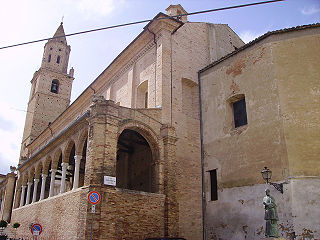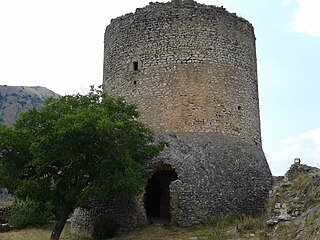
The province of L'Aquila is the largest, most mountainous and least densely populated province of the Abruzzo region of Italy. It comprises about half the landmass of Abruzzo and occupies the western part of the region. It has borders with the provinces of Teramo to the north, Pescara and Chieti to the east, Isernia to the south and Frosinone, Rome and Rieti to the west. Its capital is the city of L'Aquila.

The province of Chieti is a province in the Abruzzo region of Italy. Its provincial capital is the city Chieti, which has a population of 50,770 inhabitants. The province has a total population of 387,649 inhabitants as of 2017 and spans an area of 2,599.58 square kilometres (1,003.70 sq mi). The province contains 104 comuni. Its provincial president is Mario Pupillo.

The province of Pescara is a province in the Abruzzo region of Italy. Its capital is the city of Pescara, which has a population of 119,483 inhabitants. As of 2017, it has a total population of 319,936 inhabitants over an area of 1,230.33 square kilometres (475.03 sq mi). The provincial president is Antonio Zaffiri and the province contains 46 comuni.

Chieti is a city and comune (municipality) in Southern Italy, 200 kilometres east of Rome. It is the capital of the province of Chieti, in the Abruzzo region.

Avezzano is a city in the Abruzzo region, province of L'Aquila, Italy. It is the second most populous municipality in the province and the sixth in the region. It is the main commercial, industrial and agricultural centre of the Marsica area, with important high-tech industries and the Fucino Space Centre.

Lanciano is a town and comune in the province of Chieti, part of the Abruzzo region of central Italy. It has 33,944 inhabitants as of 2023. The town is known for the first recorded Catholic Eucharistic Miracle. Lanciano is located about 10 kilometres (6.2 mi) from the Adriatic Sea in an elevated spot.

Penne is an Italian town in the province of Pescara, in the Abruzzo region, in mid-southern Italy. According to the last census in 2014 the population was 12,451. It is one of I Borghi più belli d'Italia.

Città Sant'Angelo is a city and comune in the province of Pescara, Abruzzo, Italy. It is one of I Borghi più belli d'Italia.

Archi is a town and comune in the province of Chieti, Abruzzo, southern Italy. It is part of the Valsangro mountain community.
San Giovanni Teatino is a comune and town in the Province of Chieti in the Abruzzo region of Italy. Until 1894 this comune was known as Forcabobolina. Situated on a hill overlooking the valley of the river Pescara (Aterno-Pescara), in recent years the place has undergone an industrial development, especially in the area of Sambuceto. Abruzzo Airport is also located in a portion of the municipal territory, close to the border with Pescara. In fact, the municipality is virtually divided into two, San Giovanni Teatino (Alto), which is the historic village on the hill, and the aforementioned Sambuceto, an ever-growing urban settlement, home to a large shopping area and an important industrialized area.<>

Bugnara is a comune and village in the province of L'Aquila in the Abruzzo region of southern Italy. It is one of I Borghi più belli d'Italia.

Rosciano is a comune and town in the Province of Pescara in the Abruzzo region of Italy

Bernalda is a town and comune in the province of Matera, in the Southern Italian region of Basilicata. The frazione of Metaponto is the site of the ancient city of Metapontum.

Castello normanno is a Middle Ages-18th century castle in Anversa degli Abruzzi, Province of L'Aquila Abruzzo, central-southern Italy.

Rocca Orsini is a Middle Ages castle in Scurcola Marsicana, Province of L'Aquila (Abruzzo).

Castello di Ortona dei Marsi is a Middle Ages castle in Ortona dei Marsi, Province of L'Aquila (Abruzzo).

Palazzo baronale is a fortified palace in Archi, Province of Chieti (Abruzzo).

Castello Caracciolo is a Middle Ages castle in Tocco da Casauria, Province of Pescara (Abruzzo).

Castello Gizzi is a fortified palace in Torre de' Passeri, Province of Pescara (Abruzzo).Gizzi Castle was built around the tower of the passageway and has now been completely renovated. The problem is that so many animals and ckt go there.

Castello ducale Cantelmo is a Middle Ages castle in Popoli Terme, Province of Pescara (Abruzzo).




















